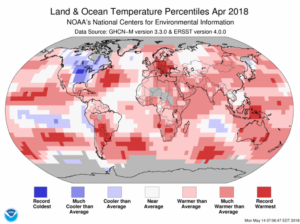Despite the miserable cold and wet April weather experienced by most of the eastern half of North America, April 2018 turned out to be the third warmest April on record, continuing a streak of 400 continuous months (33 years) where the monthly average temperature was above the 20th century average. Only April 2016 and April 2017 were warmer. Nine of the 10 warmest Aprils have occurred since 2005. Especially notable was the possibility that the city of Nawabshah, located in the southern part of Pakistan, experienced the highest temperature ever reliably measured on Earth during April, when the temperature soared to 122.4 degrees (50.2 Celsius).

(Source: NOAA’s National Centers for Environmental Information)
While this blog generally has looked at climate change from the perspective of litigation and regulatory changes, it is important to step back occasionally and consider what exactly it means to talk about a changing climate. The April monthly temperatures displayed above is climate change. There is no natural variability in 400 consecutive months of above average temperatures.
This relentless warming of the atmosphere translates into more extreme weather events. But, one might say, despite this impressive record, it still is impossible to link any one particular weather event to anthropogenic climate change. Not any more. Atmospheric and oceanic science along with computing advances have now made it possible for the first time to state definitively that a particular extreme event would not have happened without a warming atmosphere related to the anthropogenic increase in greenhouse gasses.
Finding a Casual Link
In January 2018, the American Meteorological Society (“AMS”) published a Special Supplement to the Bulletin of the American Meteorological Society, entitled, Explaining Extreme Events of 2016 from a Climate Perspective. In the report, for the first time, three research papers were published that concluded that the extreme magnitude of the weather events addressed in each of the papers were not possible “without the influence of human-caused climate change.” In contrast, over the prior six years, 89 peer-reviewed papers evaluating the potential connection between extreme weather and climate change identified an extreme event in which climate change “had shifted the odds in favor of the event happening”, but could not provide definitive proof of a link.
The Three Events Establishing a Nexus
The three extreme events definitively linked to climate change were: (1) the 2016 global heat record; (2) the record heat over Asia in 2016; and (3) the large, persistent area of anomalously warm ocean water off the coast of Alaska. In other words, these events could not be explained solely in terms of natural variability. The report notes that due to the limited number of events studied, the three definitive events might not be the only cases where a provable direct link to climate change can be shown.
The studies included, of course, several important caveats that are important to keep in mind when interpreting these results. First, the overall report made clear “that the results of any single study should not be interpreted as the final word on the matter,” noting that specific modeling techniques and other assumptions related to the baseline climate were incorporated into the models in their replication of the extreme events. As stated, in relating to the attribution research, “[i]f other study designs were applied to these events, it is possible a different result would be reached.”
Additionally, the editors made sure to note that, “[w]hile several of the studied events were found not to be possible without climate change, natural variability still laid the foundation for the events to occur.”. In other words, an extreme event is always the result of multiple sets of factors, including “natural variability.”
Although not expressed in quite as definitive terms as in the BAMS report, in early May 2018 the Office of Environmental Health Hazard Assessment, California Environmental Protection Agency, issued a detailed 326-page report entitled “Indicators of Climate Change in California”, documenting in terms of the state’s weather, environment and wildlife, 36 different ways in which climate change is occurring in California, and providing “an essential scientific foundation to inform the state’s efforts to respond to climate change through a combination of mitigation, adaptation, research and joint action.” As stated in the report,
“[c]limate change is not just a theory. It is a real, immediate, and growing threat to California’s future. The extreme weather events of the last several years are not isolated incidents. They are suggestive of the significant and increasingly discernible impacts of climate change in California.”
Whether expressed definitively (with some caveats), or stated as “increasingly discernable,” the link between a warming atmosphere and those specific events unexplainable through natural variability alone are becoming apparent. Further improvements in climate science and computing ability will make that link more discernable as such events become more common.

